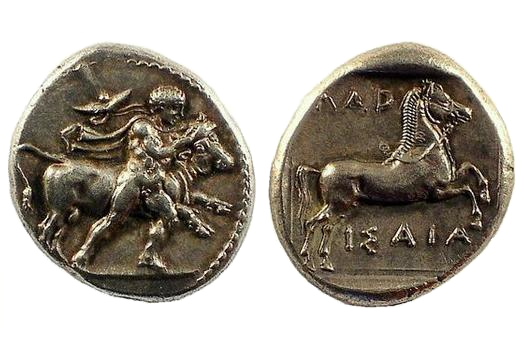
about ancient nomos
Ancient Nomos Art is a museum of galleries exhibiting ancient coins and ancient mint maps. The coin gallery displays the diverse art and history of hand-crafted ancient Greek, Roman, Byzantine, Persian and Medieval coinage. The ancient mints mapping gallery features Greek, Roman, Byzantine, Asia Minor and Medieval mint city regions and territories. Visitor's are welcome to explore, study and enjoy Ancient Nomos Art.

Greek, Thessaly – 435 BC
Larissa
From Ancient Galleries

Obverse: Youthful wrestler subduing bull by the horns, with chlamys and petasus.
Reverse: Bridled horse galloping right with a trailing rein; within square incuse.
LEGEND SYMBOLS
Obv. Naked Thessalos wrestling bull striding right, with petasus flying in the wind and cloak over his shoulder, holding a band around the head of the rushing bull’s horns. Rev. Bridled, bareback horse with trailing rein galloping right, ΛΑΡ above and IΣΑΙΑ below; all within a shallow incuse square.
The ancient city of Larissa was the leading city of Thessaly and is located inland from the Aegean along the Pineios River. The region surrounding Larissa is perhaps the most fertile agricultural land in Greece. The vast Thessaly pasture lands were well known during antiquity for the breeding of fine horses. The ancient historians believe Larissa was founded by Acrisios, father of Danae, and accidentally killed by Persus, and so named after the eponymous fountain nymph Larissa, prophetess of Apollo (Pausanius 2.24.1). The great wealth and ancient prosperity of Larissa allow her to be the most prolific mint in the region. From the early 5th century to the end of the 4th century, Larissa produced a long series of coins whose two principal themes centered on celebrating livestock and the famous Larissa fountain nymph (see: Larissa as nymph). This classical period coin features a lively action scene illustrating the Thessalian pastime of bull wrestling, a sport thought to have been associated with honor and mythic importance. Both sides of this magnificent coin taken together represent the festival game known as the Taurokathapsia. The game requires a young nobleman or “toreador” to leap from his galloping horse and wrestle down the bull on his bare feet with the aid of a band passed around the horns of the bull’s head. Perhaps the coin itself suggests that a successful outcome by Thessalos elevated his status to mythological hero in the eyes of a Thessalian? The coins obverse depicts the Thessalian wrestler in action, grasping the running bull by its horns. The reverse depicts the riderless horse galloping onward, perhaps to stable. Virtually identical coins where struck by all Thessaly during this period and is a testament to the united league of this ancient Greek city-state.
DOCUMENTATION
Value: Drachm. Metal: AR Silver. Weight: 6.28 grams. Mint: Thessaly, Larissa. Date: 435-400 BC.
Attribution: Herrmann plate III, 1; Dewing 1389; SNG Copenhagen 107; D. Gorny, 1989, 266.
Legend, Documentation and Attribution
